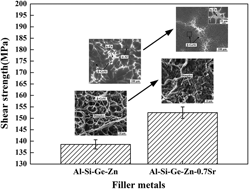Published online by Cambridge University Press: 13 December 2016

The effects of alkaline earth strontium (Sr) additions on the microstructure and properties of Al–Si–Ge–Zn alloys and brazed joints were investigated. The results showed that the appropriate addition of Sr changed the morphology of β-GeSi phases from coarse needle-like to fine granular shapes effectively. Sr addition prevented the growth of Si by Sr adsorbing on the Si surface and caused the formation of many twins in Si. Sr addition had little impact on the melting temperature of the filler metals, but the spreading areas of Al–Si–Ge–Zn–xSr filler metals increased firstly and then decreased with the increase of Sr addition. In addition, the Sr addition optimized the microstructure of the brazed joints and improved the mechanical properties. Sound joints with high shear strength up to 152.4 ± 2.5 MPa could be obtained by applying Al–9.5Si–10Ge–15Zn–0.7Sr (all in wt%) filler metal.